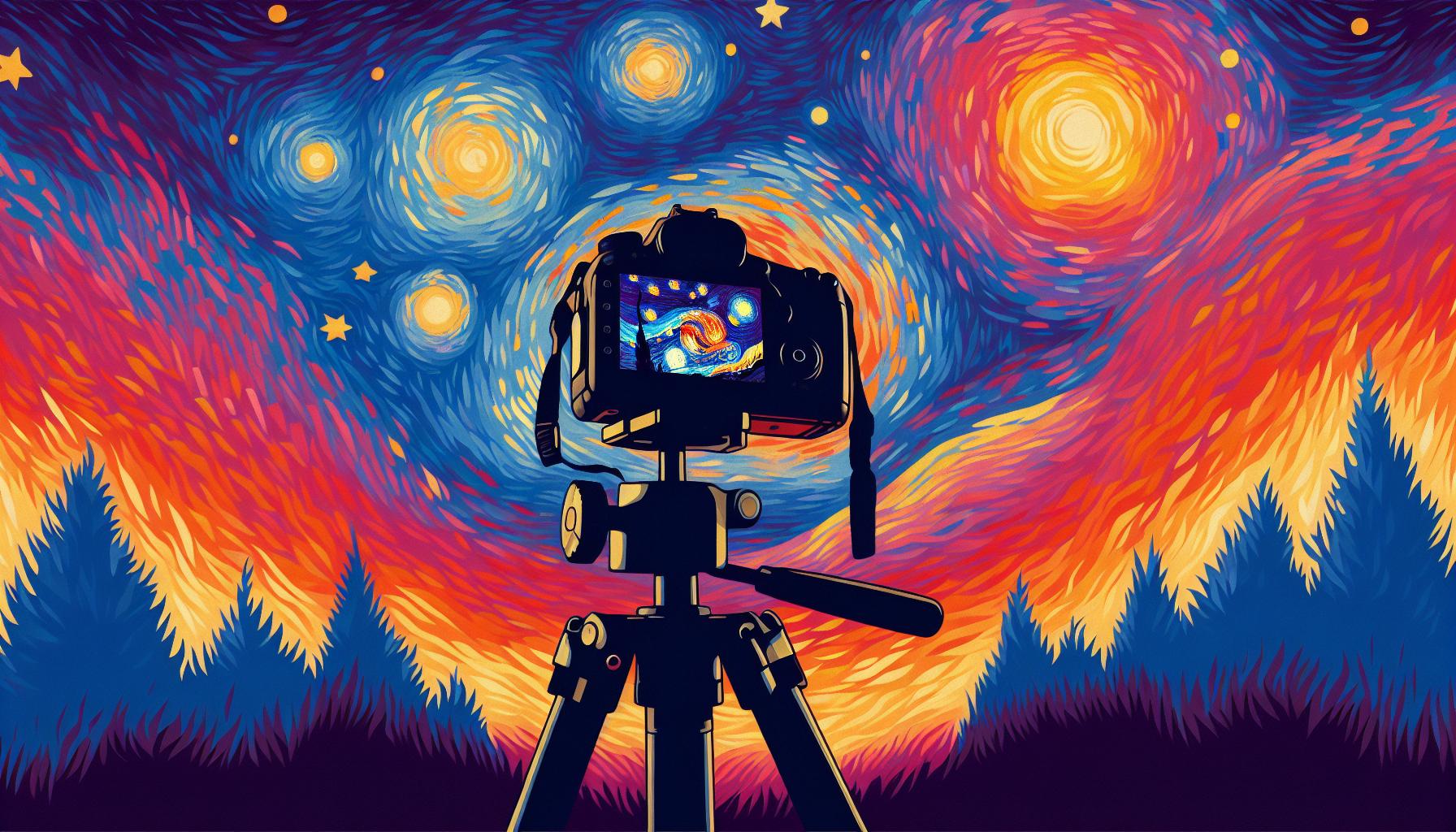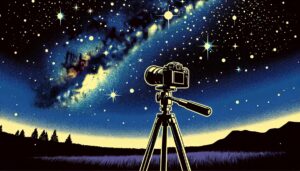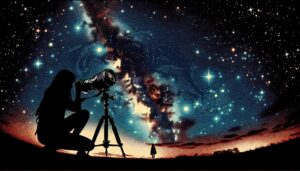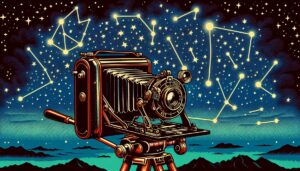This site contains affiliate links to products. I may receive a commission for purchases made through these links.
Diving into the world of astrophotography can seem daunting at first. With so many pieces of equipment and technical jargon, it’s easy to feel overwhelmed. But don’t worry, I’m here to simplify things for you.
In this article, I’ll guide you through the basics of astrophotography and help you assemble your first beginner astrophotography kit. We’ll talk about the essential gear you’ll need and some helpful tips to get you started.
Remember, astrophotography isn’t just for the pros. With the right kit and a little patience, you’ll be capturing the stars in no time. So, let’s get started, shall we?
What is Astrophotography?
If you’re scorning at the jargon, pause. Astrophotography is a term combining two areas of interest – astronomy and photography.
It’s the art of taking photographs of celestial bodies and space phenomena. Stars, galaxies, meteor showers – you name it! With the right tools and a pinch of patience, you’re able to paint an awe-inspiring canvas of cosmic wonders.
I get it; the concept might appear intimidating. You might wonder, “isn’t it something only scientists and professionals can do?” Not really! Astrophotography is for anyone who has a passion for exploration and appreciation of the skies.
Innovation in technology has brought a significant change in how we approach astrophotography. Today’s digital cameras and advanced equipment make it easier for beginners to dive right in. Needless to say, amongst the types of photography out there, astrophotography stands out as unique and enthralling.
It’s time to bring your stellar fantasies to life. Are you ready to begin your journey into the infinite world of stars, galaxies, and nebulae? We the thrill-seekers, the stargazers, and the dreamers await your entry into this mesmerizing world of astrophotography.
In the next section, we’ll look at the equipment needed to kickstart your astrophotography pursuits. Trust me, it’s not as daunting as you might think! With a beginner’s astrophotography kit, you’ll be capturing those twinkling wonders in no time.
Why Should You Start with a Beginner Kit?
Whether you’re smitten by the night sky’s artistic allure or seized by its scientific intrigue, diving into astrophotography can be daunting. Embracing the beginner’s mindset is the surest leap into this wondrous endeavor. That’s where a beginner astrophotography kit comes kicking into the frame. Choosing this path, you’re not only easing yourself into a complex art form, but also sparing unnecessary expenses and technical pitfalls.
Getting comfortable with the equipment is the unsung hero of astrophotography success. Managing a basic setup before journeying into advanced territory lets you grasp the ropes without overwhelming yourself. The beginner kit typically includes a telescope, a mount, and a camera: the tripod of astrophotography. Mastering their operations can graduate you from beginner to amateur astrophotographer, making it an ideal starting point.
Another sweet spot in favor of the beginner kit is the cost. Astronomy might be about stars, but astrophotography doesn’t have to mean reaching deep into your wallet. Investing in basic, effective equipment before upgrading to high-end gear is prudent. This way, you will avoid burning a hole in your pocket only to realize you’re not as starstruck as you thought.
Let’s not forget that astrophotography is a mixture of technology and art. The learning curve can, at times, get steep as you balance technical skills, artistic sense, and a dash of patience. However, that’s what the beginner’s kit is for: to alleviate the initial complexity and allow an easier foray into capturing the cosmos.
Embrace the adventure and unfold your cosmic journey. Maybe the stars won’t seem so far away after all. But remember, every epic journey begins with a single step, or in this case, a beginner kit.
In the next segment, we’ll dive deeper into what one should look for in an astrophotography kit. We’ll break down the importance of each component, how to judge quality, and what can be skipped in the beginning. Soon, you’ll have a solid grasp on how to get started on your astronomical adventure.
Essential Gear for Astrophotography
Let’s dive right into the integral elements of a beginner astrophotography kit. From telescopes to mounting systems, these tools play pivotal roles in creating awe-inspiring images of the cosmos.
A telescope is the essence of astrophotography. How vast the universe is or how minute celestial bodies appear, depends largely on the lens and the focal length of your telescope. Reflecting telescopes are a go-to for beginners due to their relatively low cost and high versatility.
Mounted on the telescope, a high-performance camera becomes your window to the stars. Any digital single-lens reflex (DSLR) camera would suffice for your debut into astrophotography. As you grow in this art form, you might want to consider an astronomical CCD camera designed specifically for the job.
Without a good mount, the clearest skies are just wasted opportunities. An equatorial mount with motor drives allows you to cater to the Earth’s rotation, keeping your targeted objects in focus.
To further fine-tune your shots, introducing a T-ring adapter and a Barlow lens into the mix is beneficial. A T-ring adapter lets you connect a DSLR camera to the telescope and the Barlow lens magnifies the image, bringing distant galaxies within your grasp.
Lastly, consider a reliable laptop armed with adequate image-processing software. This software acts as your cosmic darkroom, enabling you to tweak your shots to perfection.
Note the importance of each component:
| Equipment | Importance |
|---|---|
| Telescope | Captures celestial images |
| Camera | Transform the images into digital format |
| Mount | Aligns the camera and telescope to capture images |
| T-ring adapter & Barlow lens | Allows camera & telescope connection and magnifies image |
| Laptop with image-processing software | Helps in editing and enhancing images |
Trust me, the journey of astrophotography is full of adventure and discovery. While the initial investment may seem steep, remember it’s a long game. As your passion and skills grow, you’ll find the investment well worth the cost. Strap in and get ready to explore the universe from your backyard using your beginner astrophotography kit. The next section will take you deeper into choosing the right gear.
Camera and Lens Recommendations
Let’s delve into specifics now. Picking the right camera and lens can seem daunting. Yet, don’t worry, I’m here to ensure you make a confident call.
DSLR and Mirrorless cameras are widely praised within the astrophotography community. Their top-notch image sensors capture outstanding detail and vibrant colors. They’re also extremely versatile, allowing you to shoot everything from wide-field images of star clusters, to planets and galaxies.
Among DSLRs, the Canon EOS 60Da is a solid choice for astrophotography. It’s specifically designed to capture red hydrogen emission nebulae thanks to its increased sensitivity to the hydrogen-alpha (H-α) wavelengths. Don’t forget about Nikon D810A, another gem in the DSLR category. It’s renowned for its high ISO sensitivity and dynamic range, pivotal features for capturing cosmos’s beauty.
Mirrorless cameras are lighter and often less expensive. The Sony a7S II shines in this field. Its ultra-high sensitivity and wide dynamic range aid capturing faint stars and nebulae.
The lens determines what you can capture and from what distance. With wide-angle lenses, you can depict vast stellar landscapes while telephoto lenses are perfect for capturing far-off celestial bodies. For wide-angle astrophotography, look into the Sigma 14mm f/1.8 DG HSM Art lens. It’s fast aperture is excellent in low-light conditions. On the flip side, the Canon EF 200mm f/2L IS USM is a fantastic telephoto lens that excels at closer, detailed images of astronomical phenomena.
Here’s a quick markup of the recommended cameras:
| Category | Camera |
|---|---|
| DSLR | Canon EOS 60Da |
| DSLR | Nikon D810A |
| Mirrorless | Sony a7S II |
Recommended lenses:
| Type | Lens |
|---|---|
| Wide-Angle | Sigma 14mm f/1.8 DG HSM Art |
| Telephoto | Canon EF 200mm f/2L IS USM |
Choosing will come down to your preferences and budget. Remember, astrophotography is a journey. Don’t be disheartened if you can’t afford the best gear immediately. The most important part is enjoying the process. Up next, we’ll delve into the significance of mounts in astrophotography.
Tripods and Mounts
Moving from lenses and cameras, let’s get into another crucial aspect of astrophotography – tripods and mounts. In the world of astrophotography, a sturdy setup holds great significance. It’s worth investing in a good quality mount to avoid blurry images, which can often plague beginner astrophotographers.
First, let’s discuss tripods. A robust and stable tripod is a must-have for astrophotography. Tripods designed for outdoor photography, like the Manfrotto 055CFB or the Benro Mach3, perform exceptionally well. These are built for stability and can handle considerable weight, which is essential given the often heavy lenses and cameras involved in astrophotography.
As for mounts, there are two types to consider – altitude-azimuth mounts (Alt-Az) and equatorial mounts (EQ).
- Altitude-azimuth mounts are easier for beginners, as they move in simple, up-down and left-right motions. Models like the Celestron NexStar 6SE are fantastic starters if you opt for Alt-Az.
- Equatorial mounts, on the other hand, are designed to follow the earth’s rotation. This feature makes them vital for deep sky imaging. For entry-level equatorial mounts, consider the SkyWatcher EQM-35, which provides solid performance without breaking the bank.
While mounts can seem intimidating at first, understanding your requirements and constraints can make the selection process less daunting.
Now that I’ve described tripods and mounts, you shouldn’t overlook the importance of imaging software. But more on that in the next section.
Additional Accessories
After you’ve selected your camera, lenses, tripod, and mount, it’s time to explore some additional accessories that can take your astrophotography to the next level. These extras aren’t strictly necessary but can make your experience much smoother and productive.
Firstly, remote shutter releases are worth considering. When doing long-exposure shots, even the smallest shake can ruin your image. By using a shutter remote, you can avoid touching the camera directly, reducing the risk of blur. There are two types of these: wired and wireless. Both have their advantages, though I find wireless to be more convenient and versatile.
Second, an intervalometer is a valuable tool for astrophotographers hoping to capture time-lapse images. This device can automate your camera’s shutter at intervals, freeing you to sit back and observe the stars while your camera works.
Next, an extra battery or battery grip can be a lifesaver in astrophotography. Long exposure and cold nights can drain your battery very fast. Having a spare battery or a battery grip (which holds multiple batteries) ensures you won’t miss out on great shots because of power issues.
Equally important, don’t forget a good quality memory card. Raw images, common in astrophotography, take up a lot of space. A memory card with high capacity and fast write speed will serve you better.
Budget-wise, you don’t have to break the bank. I’d recommend cheap, reliable options like the Neewer intervalometer, Wasabi Power batteries, or SanDisk Extreme memory cards.
Remember, these accessories aren’t mandatory. Yet, they can make the whole process easier, granting you more enjoyment in photographing the night sky. As you grow and learn more about astrophotography, you might find other accessories that suit your specific needs.
Tips for Getting Started
Embarking on an astrophotography journey can seem daunting at first. But don’t let it intimidate you. Instead, embrace the challenge. With just a few simple tips and tricks, you’ll be capturing the wonders of the night sky in no time.
First things first. Practice makes perfect. Begin by taking pictures of anything and everything. This will help familiarize you with your camera settings and functions. It’s also a fantastic opportunity to understand how different lighting conditions impact the shot.
Understanding your camera is key. Invest time in learning the ins and outs of your device. Get to know aperture, shutter speed, ISO, and white balance. These are fundamental aspects of astrophotography.
Let’s talk location. Find a place away from bright city lights. Dark skies make for dramatic astrophotography. A little research can lead you to fantastic, lesser-known spots. Moreover, always check the weather before planning a shoot. Clear skies are perfect for such endeavors.
Don’t ignore the moon cycles. They can greatly influence your shots. During a new moon, you’ll have a better chance of capturing the milky way. On the other hand, a full moon illuminates the night sky, ideal for lunar landscapes.
Astrophotography can seem tricky initially. It’s a balance of patience, practice, and learning. But remember, every professional was once a beginner.
Need some more guidance? I’ve rounded up a quick checklist for getting started.
- Grab a solid tripod
- Invest in a good DSLR or mirrorless camera
- Have a wide-angle lens
- Ensure having a memory card with enough storage
- Pack an extra battery
- Use a remote shutter release
Claim your space amongst the stars! Get started with astrophotography today. As you learn and grow, you’ll discover the joys of capturing the night sky, your way.
Conclusion
So you’re ready to dive into the world of astrophotography. Remember, it’s all about patience and practice. Mastering your camera settings and finding the perfect dark sky location are key. Don’t forget to keep an eye on the moon cycles too. As for gear, you can’t go wrong with a sturdy tripod, a DSLR or mirrorless camera, a wide-angle lens, and plenty of storage and battery power.
Embrace the challenge, astrophotography is a journey, not a destination. Keep this checklist handy as you embark on your new adventure. And stay tuned, because I’ve got plenty more advanced techniques and tips to share in upcoming posts. Happy stargazing!




